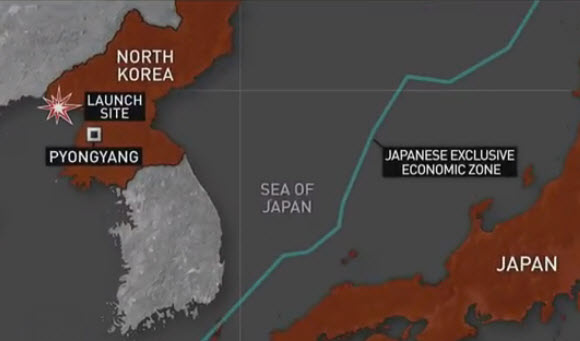With a Year of Gains, North Korea Startles the West
And they may have the ultimate weapon Mar 24 2017Over the past year, North Korea has made remarkable strides toward its goal to develop intercontinental ballistic missiles carrying nuclear warheads to the West Coast of the United States. There follows a timeline, and at its conclusion a devastating assessment that North Korea may already have far worse — a doomsday weapon:
![]() In January 2016, North Korea conducted its fourth nuclear test, claiming it was a hydrogen bomb, although that was doubted.
In January 2016, North Korea conducted its fourth nuclear test, claiming it was a hydrogen bomb, although that was doubted.
![]() In February a year ago, Pyongyang successfully put a satellite into orbit with a three-stage rocket. Their ministry claimed a range of 7,400 miles and a payload of as much as 1,300 pounds, both exceeding the missile it tested in 2012 and enough to reach West Coast if reconfigured as a missile.
In February a year ago, Pyongyang successfully put a satellite into orbit with a three-stage rocket. Their ministry claimed a range of 7,400 miles and a payload of as much as 1,300 pounds, both exceeding the missile it tested in 2012 and enough to reach West Coast if reconfigured as a missile.
![]() This violation led in March to further sanctions imposed by the United Nations that included cargo inspections and a cutoff of aviation fuel.
This violation led in March to further sanctions imposed by the United Nations that included cargo inspections and a cutoff of aviation fuel.
![]() Meanwhile, according to U.S. intelligence, North Korea had expanded its uranium-enrichment facility and reactivated plutonium production at secret underground sites that would be difficult to target with airstrikes in North Korea's mountainous terrain.
Meanwhile, according to U.S. intelligence, North Korea had expanded its uranium-enrichment facility and reactivated plutonium production at secret underground sites that would be difficult to target with airstrikes in North Korea's mountainous terrain.
![]() In March of last year, North Korea announced a successful ground test of a solid fuel rocket engine of new design.
In March of last year, North Korea announced a successful ground test of a solid fuel rocket engine of new design.
![]() In April came a successful ground test of a newly designed intercontinental ballistic missile engine. And North Korea launched three tests of its Musudan missile, intended to reach targets of American bases as far as Guam, but all crashed into the sea or exploded seconds after takeoff (see "Cyber Not Enough" in companion story).
In April came a successful ground test of a newly designed intercontinental ballistic missile engine. And North Korea launched three tests of its Musudan missile, intended to reach targets of American bases as far as Guam, but all crashed into the sea or exploded seconds after takeoff (see "Cyber Not Enough" in companion story).
![]() In May, American and South Korean intelligence concluded that North Korea can now mount small nuclear warheads on short- to medium-range missiles and strike much of Japan and South Korea.
In May, American and South Korean intelligence concluded that North Korea can now mount small nuclear warheads on short- to medium-range missiles and strike much of Japan and South Korea.
![]() In June, two more Musudan failures, but an intermediate-range ballistic missile was sent to 878 miles of altitude that was interpreted as work on mastering the technology needed to keep a nuclear warhead from burning up on re-entry into the Earth's atmosphere. At a normal angle a U.S. analyst said it could have reached 2,480 miles.
In June, two more Musudan failures, but an intermediate-range ballistic missile was sent to 878 miles of altitude that was interpreted as work on mastering the technology needed to keep a nuclear warhead from burning up on re-entry into the Earth's atmosphere. At a normal angle a U.S. analyst said it could have reached 2,480 miles.
![]() In September, North Korea conducted its fifth nuclear test and three missile tests, totaling about 20 for the year. Pyongyang said it tested a miniaturized nuclear warhead that could be placed on a missile. The U.S. expressed belief that North Korea already has small enough warheads to fit on short-range missiles aimed at South Korea. The North also launched a missile from a submarine, showing it now possesses second strike capability. Obama promised, "additional significant steps, including new sanctions to demonstrate to North Korea that there are consequences to its unlawful and dangerous actions" to which a Wall StreetJournal editorial answered, "Yada, yada, yada".
In September, North Korea conducted its fifth nuclear test and three missile tests, totaling about 20 for the year. Pyongyang said it tested a miniaturized nuclear warhead that could be placed on a missile. The U.S. expressed belief that North Korea already has small enough warheads to fit on short-range missiles aimed at South Korea. The North also launched a missile from a submarine, showing it now possesses second strike capability. Obama promised, "additional significant steps, including new sanctions to demonstrate to North Korea that there are consequences to its unlawful and dangerous actions" to which a Wall StreetJournal editorial answered, "Yada, yada, yada".
![]() In October, the Musudan failed again.
In October, the Musudan failed again.
![]() This February, North Korea showed it has learned how to produce solid fuel, introducing it aboard the Pukguksong-2, a nuclear-capable ballistic missile that was sent on a high trajectory into space indicating another re-entry test. This is the flight that interrupted the dinner at Mar-a-Lago with the Japanese Prime Minister Shinzo Abe at the table.
This February, North Korea showed it has learned how to produce solid fuel, introducing it aboard the Pukguksong-2, a nuclear-capable ballistic missile that was sent on a high trajectory into space indicating another re-entry test. This is the flight that interrupted the dinner at Mar-a-Lago with the Japanese Prime Minister Shinzo Abe at the table.
![]() In March — we're now up to date — North Korea, ordered by Kim Jong-un, simultaneously launched four mid-range missiles 620 miles into the
In March — we're now up to date — North Korea, ordered by Kim Jong-un, simultaneously launched four mid-range missiles 620 miles into the
Sea of Japan, three of them falling in Japan's exclusive use economic zone.
getting it wrong
In May, less than a year ago, The New York Times said experts were confident that North Korea is years away from deploying an intercontinental ballistic missile capable of striking the mainland of the United States with a nuclear payload. Progress is making those experts look foolish, with Pyongyang now pledging such a launch this year.
A more troubling assessment in a Journal op-ed co-authored by former CIA chief James Woolsey that says North Korea has the missiles KN-08 and KN-14, both mobile launched, probably nuclear–tipped, and already capable of striking the U.S. mainland. The second author, Peter Pry is chief of staff of the Congressional EMP commission, and he has far worse news to convey. EMP stands for electromagnetic pulse, "the most dangerous weapons known to man", and he says North Korea may already have this technology. A low-yield nuclear device adapted for EMP and detonated over North America could send gamma rays to earth that could permanently fry the U.S. and Canada grid as well as all electronics, leading to death by starvation of 90% of our populations and bringing both nations to an end.
Please subscribe if you haven't, or post a comment below about this article, or
click here to go to our front page.

